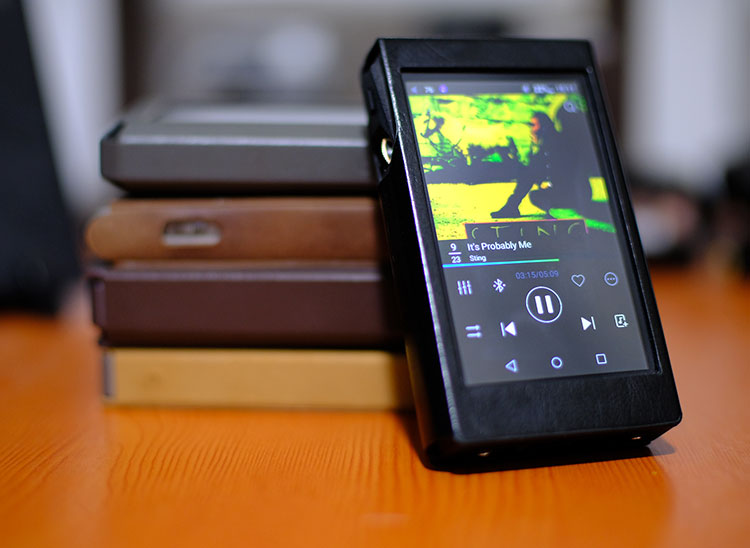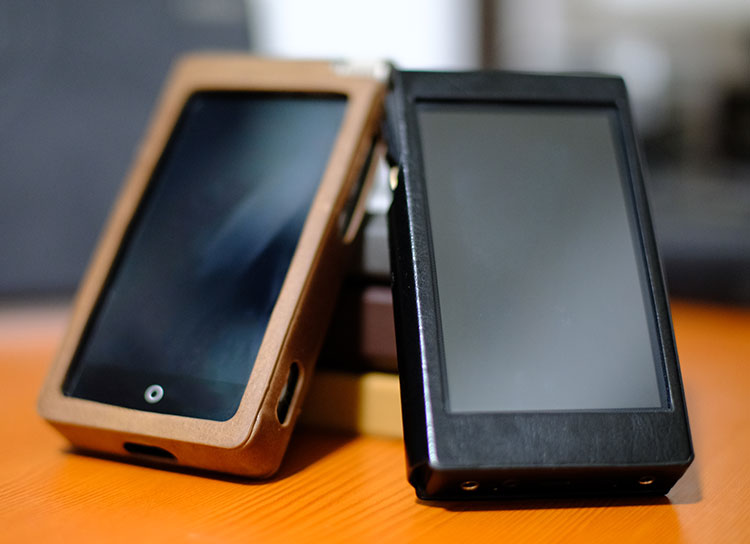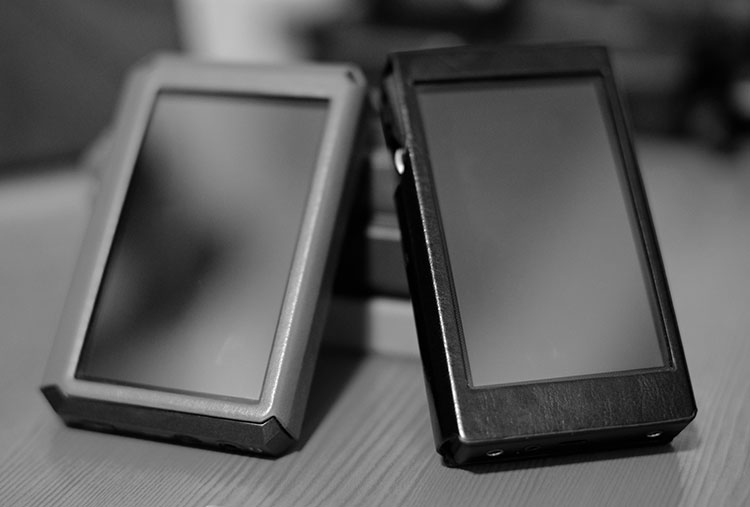Sound Impressions
Summary
For the last few years FiiO was steadily moving towards a more neutral tone to their DAPs but with the X5iii its almost a 180-degree u-turn to the days of old when a FiiO DAC or original X3 DAP were classified as warm, rich and pleasing to the ear.
Whilst the old Wolfson chip is not as detailed or dynamic sounding as the AK4490EN the intent to return to pure enjoyment rather than analytical prowess is quite clear.
Smooth
The X5iii is a smooth consumer-type tonal presentation with an accent on delivering a full sounding low end, rich and natural sounding mids, and a laid back treble response. I would not go as far as to say it is an overly warm or wooly presentation, far from it.
The sound is entirely within keeping for an AK4490EN DAC source with an emphasis on musicality and a good level of resolution so whilst it is not ‘in your face’ it does not lack anything in terms of good detail.
Staging
Staging has excellent depth and very good width with far better levels of a low-end presence than the old X5ii. Top-end extension is very good but just a touch laid back so it might not yield as much headroom or final octave articulation as some Sabre DAC infused DAPs.
Time
Now it could well be a consequence of firmware upgrading from v1 to v1.1 or a burn-in related activity but the tonal presentation I had at the start was not as convincing as the one I have now. Out of the box, I thought it a little compressed and flat sounding and lacking in dynamic range compared to even the single-chip i5.
But give it time and plenty of hours and the sound did indeed open up in terms of dynamics and clarity though I would still contend it still has a slightly laid back character to it and a certain soft but sweet sound to its timbre.
Bass
If the Cayin i5 bass response could be described as ‘bombastic’ then the X5iii stock bass response could be sloganed as “phat” sounding. The X5iii low-end signature has a meaty low-end presence with excellent texture and detail with just about every IEM and moderately powered headphone I could throw at it.
It has some elevation, granted, but it doesn’t sound bloated nor does it bleed into the mids. A neutral IEM pairing will lap this type of bass response up. Unlike the i5 though it is not as hard-hitting or as forward sounding. Instead, it has a slightly softer more lush sounding attack that I find more suitable for modern RnB and ambient chill than harder-hitting EDM.
VIPER Dynamic System
If you want to increase the impact and sub-bass presence on the X5iii I heartily recommend the Dynamic System VIPER Effect (free). The increase in low-end power whilst retaining clarity using this preset is phenomenal.
Mids
The X5ii midrange timbre is smooth, slightly euphonic in character at times though natural-sounding vocals and good instrumental separation though not quite on the level of the X7.
Whilst I couldn’t say the precision and control “could turn on a dime” there is nothing smeared sounding in the X5iii midrange delivery. Spatial cues and transient responses are accurate and nuanced enough with good micro-detail retrieval to paint a more vivid and involving presentation than the old X5ii was capable of.
Vocals
Vocal performances are sibilant free and rich in texture with a slightly forward staging position though not so far forward as the i5 and in keeping with the general timbre of the DAP though do have a slightly softer leading edge.
Upper mid-range percussion passages generally sound quite controlled actually, neither thinned out and too splashy but at the same time, they never come across as overly subdued or simply boring sounding. If you need a touch more bite I would opt for VIPER Clarity or a small amount of 3-5k EQ.
Treble
Treble on the X5iii is smooth, neutral to laid-back, and inoffensive at times yet retains a healthy level of detail for good IEMs to work with.
Compared to the X5ii it is less forward sounding so it might give the perception of being less detailed but in truth, the X5iii treble is more refined and less grainy a natural-sounding coloration, particularly in higher-pitched percussion attacks and synth sequences.
It does though lack a little in the final octave reach and articulation as the X7’s Sabre DAC with one of the better amp modules such as the AM5 is capable of offering. There is a greater level off roll-off so it won’t offer the same level of headroom and it is one of the primary areas out of the box that needed opening up a bit more in terms of dynamics.
Spectrum Extension
Again, I would encourage the use of VIPER Effects to tweak a little more in terms of perceivable treble presence and push forward the X5iii capabilities in terms of detail retrieval. One excellent, and the free setting is the Spectrum Extension option.
It will encode the X5iii’s treble response a little bit differently to the low end to bring out a little more focus on articulation and presence in the final octave.
Synergy
Efficiency
The X5ii amp is not a completely noise-free amp with efficient BA IEMs lower than 20Ω such as the Campfire Audio Andromeda and SE846 exhibiting a degree of background hiss during quieter passages of play and for a few seconds after playback has stopped before the amp circuit closed down the signal.
Connection noise (The noise you hear when inserting a jack into an amp jack port and it makes full contact) is also a little louder than most other DAPs I have previously tested.
Ideal Pairings
This actually surprised me given most, if not all previous FiiO DAPs are excellent performers when it comes to noise control for efficient IEMs and certainly the X5ii doesn’t exhibit the same level of noise. If you are packing a medium to low-efficiency IEM, say 30Ω and less than 110dB SPL it is unlikely this will be an issue but it is something to be aware of.
For example, RHA’s 150Ω 89dB CL1 up to around Noble’s Savanna at 30Ω are otherwise very well controlled with zero noise or hiss. Of course pretty much all IEMs, apart from maybe the CL1, will have no need for any high gain setting.
Catch-All Amplification
This sort of reminds me of the original teething issues of the Cayin i5 and the balanced output of the N5 when it came to noise and amplification.
Subsequent firmware updates seem to have dealt with that aspect and Cayin was quick to mention that the original concept was to have an amplification stage that was a sensible balance between IEM efficiency and enough power to drive decent headphones.
I can only suspect when FiiO mentioned customizing the amplification stage that they had the same principle in mind, a sort of ‘catch-all’ amplification stage. Will subsequent firmware updates tackle the noise levels? One can only hope so.
Power
For portable headphones and modern efficient planars, the X5iii is excellent. The only consideration really is tonal pairing because otherwise, power and the ability to properly drive headphones such as these are not an issue.
Dynamic headphones such as the 24Ω Sony MDR-Z1000 sound punchy and clean, and efficient planar standards such as the Hifiman Edition X V2 and the HE400s likewise sound smooth and full sounding with good dynamics.
Output power does drop down considerably to ≥28 mW(300Ω / THD+N<1%) in an unbalanced mode for headphones around 300Ω so whilst you will get good voltage output into the HD800 and decent volume in high gain mode it doesn’t drive it optimally for me, particularly with the 5-7k response sounding a bit too tizzy for me and a reduced level of dynamics.
Once you drop down the impedance scale you will get a fuller more confident sound so within the range are cans like the HD700 (high gain unbalanced) and the excellent AKG K872 at just 32Ω.
Balanced Output
I am sort of scratching my head a little on the ratings for FiiO’s all-new balanced output on the X5iii. Going single-ended it is the usual <1Ω (32Ω loaded) which is where you want to be for most IEMs and decent headphones also.
Balanced 2.5mm TRRS on the X5iii is rated at <3Ω (32Ω loaded) which I consider to be a bit on the high side compared to say the Opus#1 at 1Ω and also the other dual AK4990 creation, the premium AK380 also at 1Ω. Even more curiously the balanced output power ratings actually measure less than the single-ended output at 16Ω 400 mW max output compared to 16Ω 480 mW.
On more efficient IEMs you also get more noise, more so on the single-ended amp so I would hesitate to use an Andromeda, Jupiter or SE846 on the balanced output. Truth be told, at least on medium efficiency balanced IEMs such as the Fidue A91, there is not a huge amount of difference in the tonal presentation and dynamics moving from single-ended to balanced and back again.
Ultimately this feels like a missed opportunity. Unlike the AM3 on the X7, I do not feel there is a big enough qualitative difference between single and balanced output and in some cases, with that 3-ohm output impedance, it might just be preferable to go SE.
Wireless Performance
Whilst it is not the be-all and end-all in terms of qualitative Bluetooth performance it is such a welcome sight to see a FiiO DAP rocking an aptX specification in their armory of capabilities.
It can make a huge difference if your receiving module, be it a headphone or speakers can receive the additional bandwidth aptX can deliver. Even the X7 does not rock out with aptX at the time of writing.
Home
Hooking up to a set of aptX capable active speakers, the Celsus SP One‘s was a breeze with an almost instant connection during pairing mode. Distance for the signal was competitive and on par with other BT 4 devices with around 10 meters before the signal died with one artificial wall reducing it by 1-2 meters.
The quality of the signal was good also though by no means as uncompressed sounding as wired and you do need a bit more volume but much more open sounding than the X1 v2 and my ZTE Axon 7 BT 4 (non-aptX) capabilities.
Car
I also had the same ease of connection with our car BT though quality wise it was a slight drop as the BT receiver in our dodgy receiver is not aptX capable but it does work and I do have the same level of control from the dashboard or RM1 that I am used to getting.
OTG/USB DAC
USB DAC
The X5iii does require a new set of USB DAC drivers to function with Windows PC’s but installation is painless and you will be up and running in a matter of minutes with the X5iii as an external DAC/Amp. For MAC users no drivers are required. X5iii drivers are WASAPI based so check out your WASAPI driver list and simply select is using Foobar or JRiver Media Player.
From there you can line out to your amp of choice which was, in my case, the Lear FSM-02 V2 Class A output which sounded wonderfully rich and smooth. There were also no issues in handling everything from 44.1K/16BIT up to 192KHz/24BIT in terms of decoding to line out.
OTG Issues
This could be entirely anecdotal but for me, OTG through the Pure Music app or the 3rd party Onkyo HF player simply didn’t work with either the Chord Mojo or the RHA Dacamp L1.
Switching to HibyMusic did give me OTG on both devices (forced audio via USB) but sadly it was not a clean audio signal with interference and distortion on the Mojo and to a slightly lesser extent on the RHA but still audible.
Audible interference increased dramatically and then fell away when WiFi was also activated using HibyMusic. Also, any sort of app activation and usage during OTG slurred the music to an almost grinding halt.
Clearly multitasking and audio via OTG at this stage are not optimal or stable for 3rd party app use and perhaps this is why OTG is not a major feature on the X5iii home page at this point.
Select Comparisons
Rather than one specific DAP, you could actually lump most of the 2nd gen FiiO DAPs, and I include the X1 v2, into a similar group in terms of vision and sound.
The X5iii is as far removed as you can possibly think of from the previous generation in terms of aesthetics, software execution and yes, sound. You really have to look up to the X7 to see where a lot of the thinking is rather than looking down.
Hints of Old
There are some cues though for avid fans. Playback settings so actually bring a lot of the old setup options through from the previous generation as well as the standard EQ options that have a ring of familiarity.
This, however, is largely confined to Pure Music mode or the Pure Music app. For everything else, from the touchscreen, to Android, balanced output, upgrading of DAC capability, this is nothing less than a massive step forward.
FiiO X5 2nd Gen
$250
Tonally the X5iii is smoother and more refined sounding than the X5ii. The 3rd gen has superior bass both in terms of texture/detail and weight and as such delivers more power and depth to its staging than the old X5ii.
Mids are more euphonic sounding than the neutral and flatter X5ii and for some that might be a preference thing but for me, vocals do sound just that bit more natural on the X5iii.
Treble comparison though could be a topic of debate. It is perceivable that some will prefer the X5ii treble performance since it is more forward and slightly more boosted. Compared to the X5 first gen the 2nd gen got rid of that metallic leading note and replaced it with a lot more refinement.
The X5iii, on the other hand, exhibits much less grain and sounds as detailed if not more detailed than the X5iii but because of that laid-back top-end response, it’s not as dominant making the X5ii the brighter sounding of the two.
X3 2nd Gen
$150
For all of the massive leaps in technological capability that ground the 2nd gen into dust then so must we also consider the X3 2nd gen as a constant apparition in the same rearview mirror. It is that far behind it is not even worth considering unless you simply have $150 and nothing more.
Tonally is also a neutral sounding DAP in the same vein as the X5ii and is much less resolving than the X5iii’s more detailed musical sounding signature. Imaging and dynamics are more accurate, more noticeable and staging has much better depth on the X5iii.
By contrast, the X3ii sounds a little flatter, more closed in and more one-dimensional. It still sounds competitive, for the price there are not much better but it is already showing signs of technological aging and with the likely X3 3rd gen coming out this year(?) this will push it even further back.
Cayin i5
$499
Similarities
This is the stiffest competitor to the X5iii both in terms of tonal similarities and technological capability but it is $100 more expensive than the X5iii.
In terms of similarities both use the AK4990EN DAC chip implementation, both have quad-core processors, both have 4″ IPS TFT touchscreen displays with similar resolutions and whilst the i5 has a bigger battery both have similar lifecycles of around 10 hours.
Differences
Where the X5iii steps ahead are in terms of dual AK4490EN chips as opposed to just one in the i5, an OS which is Android 5.1 over the i5’s older 4.4 HibyMusic skinned version, a balanced 2.5mm TRRS output whereas the i5 has none, aptX over standard BT and of course the integration of VIPER Effect into its own dedicated app module whereas the i5 has a standard EQ module.
That is not to say you can’t download VIPER onto the i5 but it would be standalone.
The i5 still has better media management through its HibyMusic skinned Android flavor. Though it can accept 3rd party apps its 4.4 origins are tucked into the background more behind the HibyMusic platform than the X5iii’s vanilla appearance in Android mode.
You do not get an ‘Android mode’ with the i5 but do get the same healthy levels of connectivity as the X5iii with streaming, DropBox, and networked server options all available.
Tonality
Tonally the i5 is also a musical sounding DAP in the same vein as the X5iii with a weighted low end, smooth-sounding mids, and a natural-sounding treble that is not too forced or strident.
In the initial burn-in period my initial thinking was the i5 just had the edge with a slightly cleaner more precise sound, more sparkle up top, and a more dynamic and impactful low end as well as a lower noise floor.
However, with time and subsequent updating of firmware, the X5iii has caught up a lot with improved dynamics across the board. Do note at the time of writing the i5 still has the lower noise floor of the two for sensitive IEMs.
The X5iii still has a tiny bit more of a laid back smooth sound compared to the i5 but dig in a bit, particularly around the midrange and I actually think the X5iii delivers more detail and texture, particularly on vocals, and now might have the edge in terms of a resolving and spacious mid-range signature.
Treble on the i5 is just a tiny bit brighter and more forward sounding than the X5iii though the X5iii has a bit more body and slightly more natural sounding, particularly on percussion.
Shanling M5
$499
Technicalities
This is another single AKM AK4490 DAC chip DAP, priced $100 higher than the X5iii but really it is a touch dated looking in comparison with its non-touch based interface and using a skinned version of FiiO’s last-gen OS. The M5 does not have Wifi or BT, it cannot load apps or stream wirelessly in or out and by all accounts is fairly isolated from the connected world.
In its favor, it can decode to the same levels (384k/32BIT) as the X5iii given it has the same type of chip though not in a dual-channel configuration. It also has more power in unbalanced mode than the X5iii with 300mW @ 32 ohms compared to the X5iii’s 250 mW on the same load levels.
Tonality
Both have a very similar musical style with a full-sounding low end, natural mids, and smooth top end. The M5 is now quite as hard-hitting as the i5 and falls into that slightly more relaxed character of the X5iii. The M5 does have a low noise floor for sensitive IEMs than the X5iii so for those sporting Andromeda’s this might be a key factor in their decision making.
For everyone else, the X5iii though is the more open and dynamic sounding of the two with a better level of resolution, a richer note and in particular offering vocal performances that sound more lifelike. Now that is saying something because I love the M5 for its vocal performance, perhaps more so than the i5 so for the X5iii to edge it could well mean a lot less playing time for the M5.
Opus#1
$549
Technicalities
At the heart of the Opus#1 is a Cirrus Logic CS4398 x 2EA Dual DAC setup with a quad-core ARM Cortex-A9 1.4GHz processor and 1GB of RAM to power it.
It also has been recently upgraded to Android 5.1 much like the X5iii but unlike the X5iii it is so heavily gimped and walled in that you can only really use the Opus#1 as a pure DAP much like the X5iii when it is in its Pure Music mode.
It also means you do not get any wider connectivity features such as BT and WiFi with the Opus#1 so streaming, DLNA, and aptX features are missing. What it does have are analog balanced, unbalanced, line-out connectivity, and USB DAC capability.
Tonality
Tonally the Opus#1 is more balanced and neutral sounding than the X5iii. It has less low-end coloration preferring instead to deliver a more linear and coherent bass response, a spacious but flat sounding midrange with vocals slightly forward but not overly so and a nice extended and articulate sounding top end.
This is not a brash or peaky signature, perhaps a little laid back but in no way lacking in detail or sounding syrupy.
By way of comparison, the X5iii sounds more lifelike in the mids with a heavier more weighted low end and a treble signature that whilst maybe not quite as airy sounding does not lack or fall behind the Opus#1 in terms of detail.
If anything the X5iii might just have a slightly cleaner attack on its treble than the very ethereal and dreamy sounding Opus#1 treble signature.
Our Verdict
The X5 3rd gen from FiiO should be considered an important benchmark for DAPs in this price range for 2017. There is no DAP out there right now at this price point that offers more in terms of technological talking points, features, aesthetics, and generally an all-around pleasing musical tonal quality.
It really is the sum of the parts with the X5iii. Alongside the Cayin i5 (which is $499), the X5iii is really attacking this sub $500 DAP category in terms of trying to cram in a ton of features without sacrificing the sound quality.
Sound
Speaking of sound, the X5iii is very much in keeping with its dual AK4490 DAC musical qualities. It’s smooth sounding and detailed, with excellent bass weight and fullness, a euphoric timbre, strong vocals, and a relaxed yet detailed top end.
It is not as resolving or detailed as the X7 but then again I think that is exactly how it should be given the X5iii is cheaper in price than the X7. It has got power, perhaps a little too high of a noise floor for super sensitive IEMs, but more than enough for medium efficiency IEMs and up to around 150-ohm cans still sound pretty good.
Focus Points
There are still some areas that do need a bit of focus such as the noise floor and the missed opportunity to put in a killer balanced output. I would also like to see a more stable or functioning OTG experience with the next OS update where multitasking apps and OTG out is not compromised.
There are also some meh points on the OS itself. These include some lag areas particularly on the audio delay on pause and play once the screen is woken up meaning you miss some audio as well as the incorrect default setting on the drill-down media management in Pure Music mode.
I do hope future firmware can cancel these out and improve performance. Also, do give it a bit of time out of the box to open up. The first few hours with it might not thrill you to bits.
Overall
Overall the X5iii is a showcase example of how a good mid-fi DAP (2nd gen) can be re-engineered into an ambitious media-savvy well built and thoroughly modern DAP and yet still keep the price point at a very attractive level indeed. It is still a work in progress but I like where this progress is going.
FiiO X5iii Technical Specifications
To view in-depth technical specifications on the FiiO X5iii, click here.









